
Climate Change Caused an Explosion of Reptiles in the Past: Study
Reptiles were the fastest to adapt to global warming during successive climate change crises in terms of bodily changes.

A long time ago, climate change caused an unexpected change in the Earth’s biosphere: even as other species underwent mass extinction, there was a significant increase in the population and diversity of reptiles.
A new study published last week in the journal Science Advances claims that a series of successive climate crises in a sixty-million-year period led to massive evolutionary radiation among reptiles, which subsequently led to an increase in their population. The study identifies the time between 295 million years ago (mya) (also known as the Permian age) to 235 million years ago (also known as the Triassic age) as the period of these evolutionary advances among reptilian populations. The study refutes earlier theories that reptillian populations grew as a result of the mass decimation of other animal groups during this period, and situates their growth in their own evolutionary history.
Reptiles were relatively rare before this.Their population increased dramatically in number and in diversity during the Triassic period. This period, in fact, was when evolution among reptiles reached its peak: most groups of reptiles currently living among us as well as their extinct ancestors — like non-avian dinosaurs and marine reptiles — grew in diversity. Paradoxically, this coincided with a rise in temperatures, combined with a release of carbon dioxide and other greenhouse gases that led to a series of successive climate crises.
This period also witnessed two mass extinction events, decimating 70% and 86% of existing populations across a nine million-year stretch from each other. Synapsids — a now-extinct mammalian group of animals — who roamed the Earth in great numbers during the Permian period declined rapidly in these mass extinctions, and reptiles, in turn, became a vital part of ecosystems around the world. Reptiles made their way everywhere, from deserts to tropical forests to aquatic and marine habitats.
For a long time, evolutionary scientists and naturalists thought that it was the disappearance of other, competitor, animal groups in the Permian-Triassic mass extinction events that helped the growth of the reptilian population. However, the current study highlights that climate itself aided reptillian growth and evolution during this period, far more directly than the creation of ecological opportunities triggered by the disappearance of competitor animal groups.
Related on The Swaddle:
An Egg ‘Inside’ Another Dinosaur Egg Was Found in Madhya Pradesh
The research applied Bayesian evolutionary analyses — a combination of relationships between species that existed in the past and their rates of evolution over time, applied to a statistical framework — to test how this happened. For their data, the researchers constructed a dataset of all major lineages of early reptiles, early synapsides, and another group of animals called early amniotes. The results of the analyses on their dataset were then juxtaposed with existing data on body sizes of animals and global temperatures from a slightly later period in time, to gain a broad overview of how animals responded biologically to climatic shifts.
Based on their findings, the researchers claimed that anatomical and morphological changesamong early reptiles coincided with the climatic shifts during the Permian-Triassic period. Further, and more specifically, some of these changes occured well before the mass extinction event during the late Permian period, around 270 mya.
Writing in Ecology and Evolutionexplaining how reptiles — particularly archosaurs, the branch of reptiles that grew into modern day crocodiles — were able to evolve to accommodate rising temperatures, Tiago R. Simões, a co-author of the study noted that they had to reduce their body size. “Archosaurs…had to change their bodies dramatically in order to adapt to the new environmental conditions…The changes also included changes in body size or the invasion of aquatic environments.”
On the other hand, lepidosaurs, or the branch that grew into modern day lizards and taratuas, were able to survive because they were already small in size and thus better adapted to cope with drastic temperature changes. “Their body sizes worked out as useful pre-adaptations to the drastic temperature changes during the Permian and Triassic,” noted Simões.
Reptiles form an important part of ecosystems around the world. They fulfill ecological roles of both predator and prey in various contexts, and as intermediary species contribute a vital role to the food web. Understanding how they evolved, especially on the face of environmental adversity that resulted in the disappearance of most other animals, can help us understand what’s in store as the ongoing climate crisis worsens.
Amlan Sarkar is a staff writer at TheSwaddle. He writes about the intersection between pop culture and politics. You can reach him on Instagram @amlansarkr.
Related


World’s Largest Ice Sheet – a ‘Sleeping Giant’ – Is Melting Faster Than Scientists Thought
